15 Beautiful Animals that are Now Extinct
 Since
recorded history, we've known that billions of species have become extinct. If
you're in tune with any conservation efforts, you've seen the warnings against
letting species die out. Timber wolves, polar bears, and pandas are among the
most recently considered endangered species. Most people have heard about the
T-Rex, mammoths, and the dodo bird. Although these famous animals get the
limelight, there are many extinct animals that most people have never heard of.
Some of them looked like alien species, some will make you wonder why they died
out at all. There are even animals that have died out so recently that
scientists are attempting to clone them back to life. Below are some of the most
interesting species we found that you may not have heard of before. In a global
effort to preserve the species still thriving on this planet, conservationists
look towards threatened species to get them endangered status, before it is too
late. Since
recorded history, we've known that billions of species have become extinct. If
you're in tune with any conservation efforts, you've seen the warnings against
letting species die out. Timber wolves, polar bears, and pandas are among the
most recently considered endangered species. Most people have heard about the
T-Rex, mammoths, and the dodo bird. Although these famous animals get the
limelight, there are many extinct animals that most people have never heard of.
Some of them looked like alien species, some will make you wonder why they died
out at all. There are even animals that have died out so recently that
scientists are attempting to clone them back to life. Below are some of the most
interesting species we found that you may not have heard of before. In a global
effort to preserve the species still thriving on this planet, conservationists
look towards threatened species to get them endangered status, before it is too
late.
15) Quagga
The quagga was a half zebra, half horse species that has been classified as
extinct since 1883. It was found in South Africa's Cape Province and in the
southern part of the Orange Free State. At the time, they roamed in vast
numbers, not unlike the buffalo in famous Spaghetti Westerns. Unlike normal
zebras, the quagga only had the stripes on the top parts of their bodies. These
stripes faded to a darker color that spread down into one uniform coat color.
Quagga - Ancestor of Modern Day Zebra
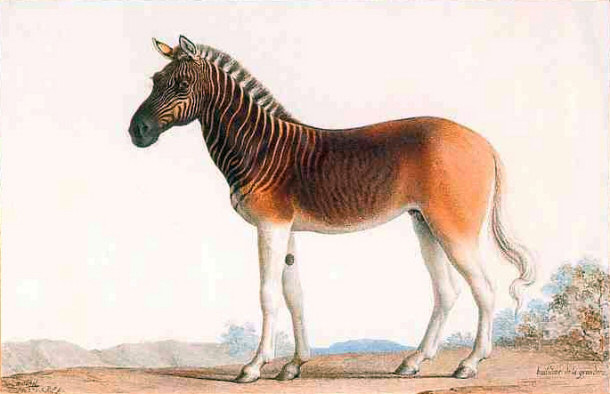
The hindquarters were a plain brown. The name is onomatopoeic, meaning that the
animal made a sound like "quagga" when it vocalized. The quagga were most likely
hunted to extinction for a variety of reasons. Their meat and hides were in high
demand, but also they competed with domesticated livestock for grazing areas.
Most likely, the last natural quagga was killed in the late 1870s, and the final
captive quagga died August 12, 1883 at the Artis Magistra Zoo in Amsterdam.
Although the quagga were classified as an individual species, there were so
many "species" of zebras, that scientists at the time were uncertain if they
were truly a species unto their own or simply a subspecies. At the time, there
were countless species and subspecies of zebra. Many of them were killed out
before they were properly identified or classified. The quagga became the first
extinct species to have its DNA studied, partially in an attempt to figure out
what classification they could be given. Recent genetic research from the
Smithsonian Institute reveals that they are part of the variable plains zebras.
14) Thylacine
The Thylacine, also known as the Tasmanian Tiger, was originally native to
Australia and New Guinea. It was the largest known carnivorous marsupial from
modern eras. The animal had a striped back similar to tiger markings and that is
where it got its name. Other common names for it were the Tasmanian Wolf, the
Tassie or Tazzy Tiger, or even just Tiger. Related species date back to the
early Miocene, although it is thought to be the last member of its genus.
Thylacine - Tasmanian Tiger
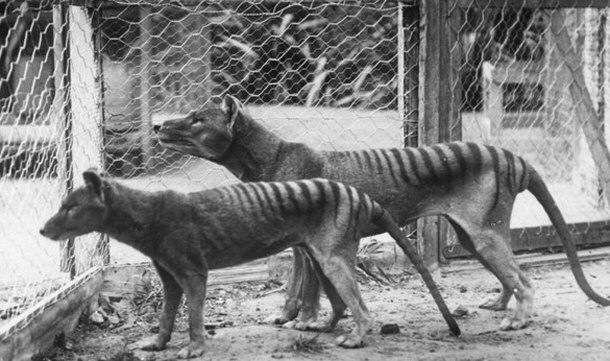
They
originally lived throughout Australia, though they died out on the main
Australian continent before the time that Europeans arrived. However, on the
island of Tasmania they were able to survive, along with other endemic species
like the famous Tasmanian Devil. Sometime in the 20th Century, the last thylacine was killed. Although hunting is thought to be the main contributor to
its extinction, it was most likely helped by disease, the introduction of dogs,
and humans invading its natural habitat. People still report sightings of the
Thylacine, but it is officially classified as extinct.
13) Steller's Sea Cow
George Steller discovered this impressive sea animal in the waters of
Commander Island, an area near the Asiatic coast of the Bering Sea. Steller was
a naturalist traveling along with the explorer Vitus Bering. This massive sea
cow, a relation to the manatee and dugong, grew to be over 25 feet long and
weighed more than three tons. In appearance, it looked similar to a large seal,
but had two stout forelimbs and a tail that resembled that of a whale.
Reconstruction of Steller's Sea Cow - 1846

Unlike
some water mammals, this tame sea cow remained in water all the time, never
coming onto land. It had black, thick skin with a small head. Instead of teeth,
it had two flat white bones on top of each other. From the evidence of fossils,
it seems it once was commonly found in the North Pacific coast, all the way
south to Japan and California. It is most likely that humans caused its
extinction. There are rumors that some populations have survived, though like
the thylacine, it is classified as an extinct species.
12) Caspian Tiger
The Caspian tiger, also known as the Hyrcanian tiger, Persian tiger, or the
Turan tiger, lived in the areas of Turkey, Tajikistan, Iran, Uzbekistan, Iraq,
Mongolia, Afghanistan, Kazakhstan, Turkmenistan, and Caucasus. It became extinct
despite being the third largest tiger of all known tiger species. In appearance,
it was similar to a common Bengal tiger and shared the species' coloring and
markings.
Caspian Tiger - Berlin Zoo, 1899
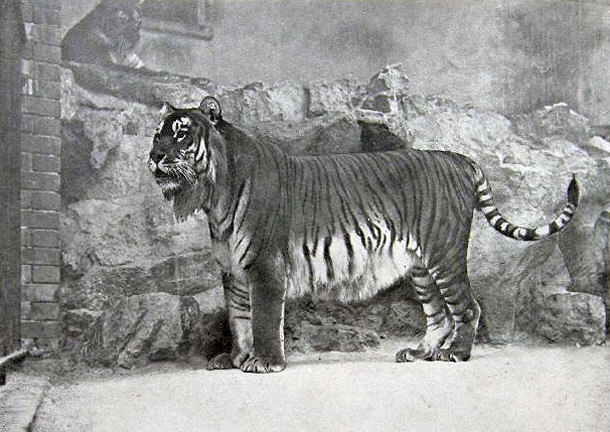
The difference was that it had stocky, strong legs and an elongated
body, huge paws and very large claws. It also had pure black patterns on the
head, neck, back, and at the tip of the tail. The fur of this tiger was long and
thick, with generous amounts found on its cheeks. The Caspian tiger's ears were
very small and short in relation to its general body size. The males could reach
up to 240 kilograms, while the females were smaller at 135 kilograms. Recently,
researchers from the University of Oxford, the U.S. National Cancer Institute
and the Hebrew University of Jerusalem have studied the similarities between the
subspecies of tigers, including the DNA of 23 Caspian tiger specimens that have
been stored in museums. They discovered the Caspian tiger's closest living
genetic relative is the Amur tiger.
11) The Jaekelopterus Rhenaniae
The Jaekelopterus rhenaniae was a eurypterid that lived 390 million years ago
that could grow over 8 feet in length. A eurypterid in an extinct version of
arthropods (simliar to arachnids). These creatures could come right out of a B
rated monster movie. The Jaekelopterus Rhenaniae was a scorpion-like creature
that kept mostly to fresh water rivers and lakes. Despite this, it is commonly
referred to as a "sea scorpion" or, as we like to call it "made of nightmares."
Fossil of Jaekelopterus, an Extinct Arthropod
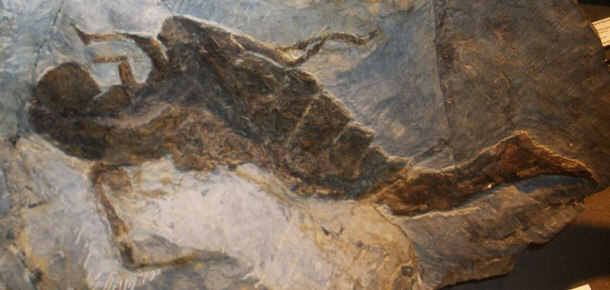
By Ghedoghedo (Own work) [CC-BY-SA-3.0],
via Wikimedia Commons
The word Arthropod is defined as an invertebrate animal who posses an
exoskeleton, segmented body based on each segments' functions, and the most
successful group of animals as far as their ability to adapt based on climatic
extremes. Organisms like reptiles or even early mammals cannot hold a candle to
the accelerated genetic adaptations and the sheer variety of arthropod species.
Their ability to reproduce exponentially allows for genetic modifications or
mutations to be recognized in much more shorter periods of time. With some
insect species like fruit flies, a flying insect who has an extremely short life
expectancy, natural selection driven by environmental factors, genetic encoding,
and mutation caused by drastically changing ecological as well as changing
environmental factors allow for researchers to gather mountains of data in a
relatively short time.
DNA Structure

Conversely, a similar study using a sample of chimpanzees of even human
beings could take decades in order to establish the dominant and recessive
traits are within a sample. Mutations could take decades to observe, document,
and begin to start drawing conclusions. Their unique talent of evolving
very rapidly to ensure their survival makes them arguably the most evolved
creatures on the planet as well as one of the oldest documented invertebrates.
Due to the fact that fruit flies reproduce so frequently, mapping the genome of
the common fruit fly, or at the very least gathering enough info from a given
sample is an extremely efficient, expedited, way of going about studying
dominant and recessive traits based on their extremely short reproductive cycle.
Arthropods account for more than three fourths of all known living and fossil
organisms, this figure equates to over one million known species in all. Although it looked very similar to a giant scorpion, this creature was more
closely related to the lobster than the scorpion. As of the writing of this
article, it is considered one of the two largest arthropods ever found. There
are still scientific debates as to whether the sea scorpion or the Arthropleura,
a giant millipede like creature, was actually larger. Regardless, this is one
creature we're fairly happy we'll never have the chance of running into. Perhaps
looking to arguably the most evolved creature on the planet - that is of course
prior to its extinction. Maybe we as humans can look to the way traits were
passed over all of those years to shed some more light on the human genome
project, as well as our understanding or dominant and recessive traits.
10) Aurochs
The Aruochs, an ancient breed of cattle, lived for millions of years before
dying off in the 1600s. They originated in India and migrated into the Middle
East and surrounding Asian areas. This cattle breed arrived in Europe as few as
250,000 years ago. Though they were prolific for countless years, they began to
die out in the early 13th century. Eventually, they could only be found in
Poland, Lithuania, Moldavia, Transylvania and East Prussia.
Aurochs - Ancient Breed of Cattle - Died off in the 1600s
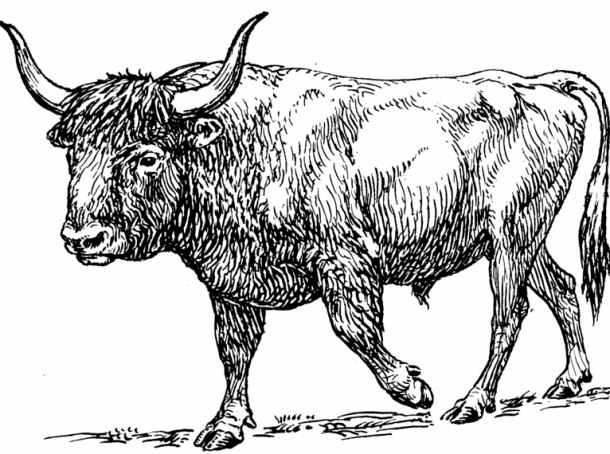
It is thought that
hunting is what contributed to their steep decline in numbers. Though hunting
began to be restricted to nobles and royalty, their numbers continued to
decline. Once it became apparent that the aurochs were dying out, the royal
court found gamekeepers to provide open fields that these massive cattle could
graze in without being hunted. This is considered to be one of the earliest
conservation efforts and for this important service, the gamekeepers did not
have to pay taxes. Additionally, anyone found to have killed one would be
punished by death.
However, this action was too little, too late and by 1564 there were only 38
animals left known. The final recorded living auroch was a female who died in
the Jaktorow Forsest in Poland in 1627. You can see her skull, which was taken
by the Swedish Army, at the Livrustkammaren in Stockholm. Two German zookeeper
brothers Heinz and Lutz Heck tried to breed back the aurochs in the 1920s
through a domesticated descendent stock program. The result was not a perfect
match for the species, but it did result in a new breed called the Recreated
Auroch, Heck Auroch, or simply Heck Cattle.
9) The Great Auk
The Great Auk, a flightless giant auk once found in the Atlantic, belonged to
its own genus, the Penguins and was also known as game fowl. It was by far the
largest of the known auks, standing around 34 inches and weighting up to 5
kilograms. Once upon a time, it was in abundance on islands off eastern Canada,
Greenland, Iceland, Norway, Ireland and Great Britain. Although it was a more
northern creature, there is some evidence that it migrated as far south as
Florida, at least back in the 14th Century. The Great Auk lived on rocky,
isolated islands from which they could easily access the waters of the ocean.
Like the modern day Emperor Penguins, it had white and black feathers, and a
black beak with hooks and grooves. The Great Auk fed on fish, and was an
excellent swimmer. Like modern penguins, it was more agile in the water than on
land, often walking clumsily. It also mated for life, nesting in dense colonies
where both parents incubated the eggs for about six weeks. The Native American
tribes held the Great Auk in high respect, using them both as food and symbols
of power.
The Great Auk - Dying Out By the Mid 1800s
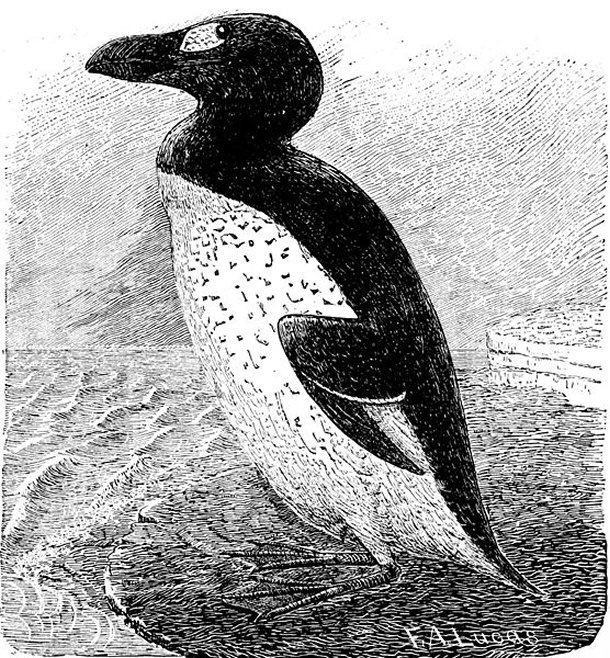
However, its down was a commodity in Europe, which made its contributed to
the population dying out by the mid-16th Century in most of Europe. Humans
continued to hunt it for food and its feathers and sometime around 1844 the last
of the Great Auks died. Once again, humans did try to counter the affects once
it was noted that they were dying out in the 1800s, but again, it was too
little, too late.
8) Gigantopithecus
The Gigantopithecus lived in the areas that are now China, India and Vietnam
from around nine million years ago until about 100,000 years ago. There were at
least three distinct species that lived around the same time, and in the same
place, as many hominin species, including homo erectus and homo sapiens. One of
the species of Gigantopithecus, the Gigantopithecus blacki, is a close relation
to the human species, included in the subfamily Ponginae with the orangutans.
Gigantopithecus blacki
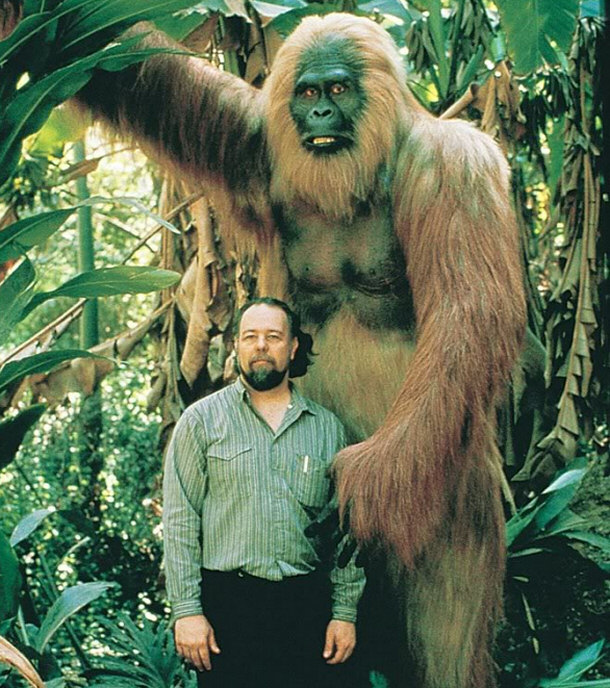
These giant apes were the largest that have ever lived, with the ability to grow
to 10 feet and weigh over a thousand pounds. It looked similar to modern day
apes, probably appearing much like what King Kong is depicted like in the
movies. Ralph von Koenigswald, while in an apothecary shop where it was common
to use fossilized bones for traditional Chinese medicine, discovered the first
fossils of the Gigantopithecus in 1935. However, there have not been many other
fossilized remains for scientists to study this giant ape. Scientists are
uncertain how they moved, since they have yet to find a pelvis or leg bones,
although most believe they probably moved similarly to modern gorillas and
chimpanzees.
7) Tarpan
The tarpan was a prehistoric type of wild horse that once roamed around
Southern France and Spain and into parts of Eastern Europe and Russia. It lived
until the 1800s in the wild, and the last captive tarpan died in 1876 at the
Ukrainian game preserve at Askania Nova. The tarpan are thought to be an
ancestor of many of the modern day domesticated horses in Europe, including all
primitive and wild horses. The name tarpan even came from the Turkic language
meaning wild horse. Because the species was alive after some other horse species
became domesticated, the term tarpan is sometimes used loosely to refer to an
all encompassing pre-domesticated ancestor of the horse.
Kherson Tarpan - Lived in Novovorontsovk Until 1880
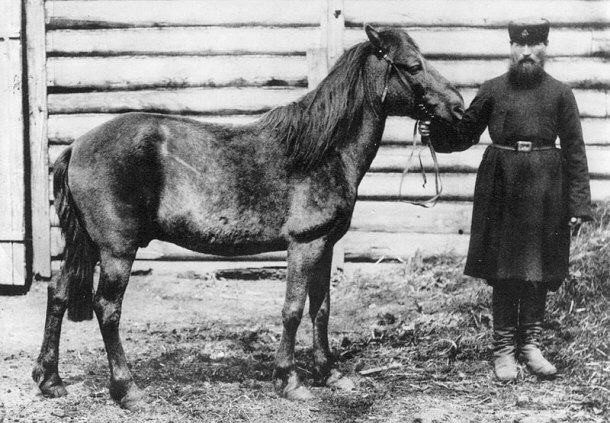
Most likely, it died out due to the destruction of its habitat in order to
make way for humans. They were also probably hunted by farmers to keep the
tarpan from eating crops and impregnating their livestock. Because they easily
interbred with horeses, tarpans were probably absorbed into the domesticated
horse population. Recently, people have tried to re-breed it. However, none of
the attempts have been successful although some slight resemblances have
occurred in the new breeds.
6) The Javan Tiger
Another tiger, the Javan tiger was only found on the Indonesian island of
Java. Smaller than the tigers found on the Asian mainland, the Javan tiger
ranged from 250 to 310lbs. Their stripes were long and thinner than other tiger
species as well. Because of their size and coat colorings, it's thought that
they spent most of their time in forested areas preying on deer,
waterfowl, and even reptiles. Up until the early 19th Century, large numbers of
the Javan tiger roamed all over the island.
Javan Tiger in London Zoo - Pre-1942
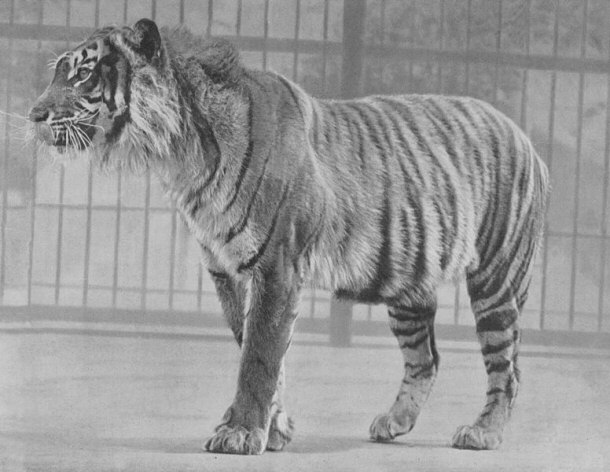
However, as more humans began to
take up residence, its natural forest habitat was destroyed, thus decreasing
their numbers. Further decreases occurred through hunting. They became so rare
that it was difficult to even put them into zoos. It was only during World War
II that some zoos were able to attempt any serious conservation efforts. By the
1950s, there were less than 25 remaining on the island, and by the 1980s they
were declared officially extinct. A wildlife preserve was founded in 1972 around
Mount Betiri. However, this did not help bring the species out of extinction.
There have been rumors of its remaining existence, though no confirmed
sightings.
5) The Syrian Wild Ass
The Syrian Wild Ass once lived in the mountains, deserts and steppes that are
now a part of Syria, Palestine, Jordan and Iraq. It was a very small animal,
only measuring one meter to its shoulder. Because it was so small and was also a
very stubborn ass, it was never domesticated. However, it was well known for
being very beautiful and strong for its relative size. It had a changing coat
depending upon the season. In the summer, its coat was tawny and olive, while in
the winter it became a pale sandy yellow. This species lived during biblical
times, and is referenced in the Old Testament. It is thought to have been the
wild ass Ishmael prophesied about in Genesis, and there are further references
in Job, Psalms, Jeremiah, and Sirach. There were reports from European travelers
in the middle ages that there were large herds roaming around.
Syrian Wild Ass Galloping in Vienna Zoo - 1915
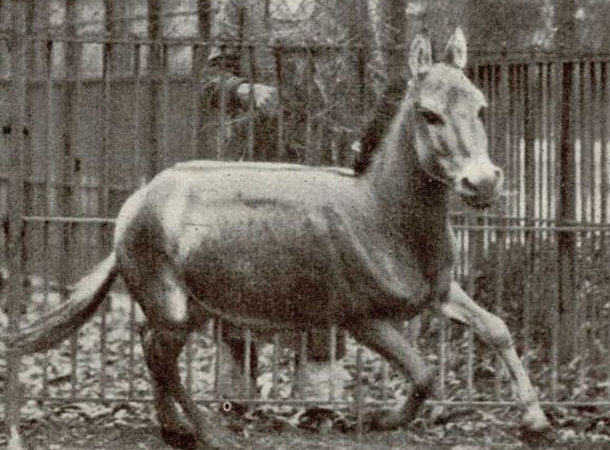
However, sometime during the 18th Century, the Syrian wild ass disappeared
from the Syrian Desert. Most likely the war between Palestine and Syria
expedited its destruction, although hunting and human populations probably
contributed to its death as well. In the 19th Century, the last living species
lived in Northern Arabia, where they continue to decline in number until they
were gone. World War I sealed their fate, as fighting forces destroyed their
only remaining habitat. The final member of the species died at Schonbrunn Zoo
in Vienna in 1928.
4) The Bubal Hartebeest
The Bubal Hartebeest, also referred to as the Bubal Antelope or Bubal, lived
north of the Saharan Desert. The ancient Egyptians worshiped it as a
mythological and sacrificial beast. For years it reigned in North Africa,
including Egypt. Its coloring resembled that of a fawn, uniform over its whole
body except for black patches on each side of the muzzle and the tuft of tail.
It stood to almost 3 feet at the shoulder with horns the shape of a lyre that
were near touching at the base. It was a highly social animal, living in herds
of hundreds of animals. They preferred to live in rocky areas that had abundant
vegetation rather than the many desert plains of Africa.
Bubal Hartebeest
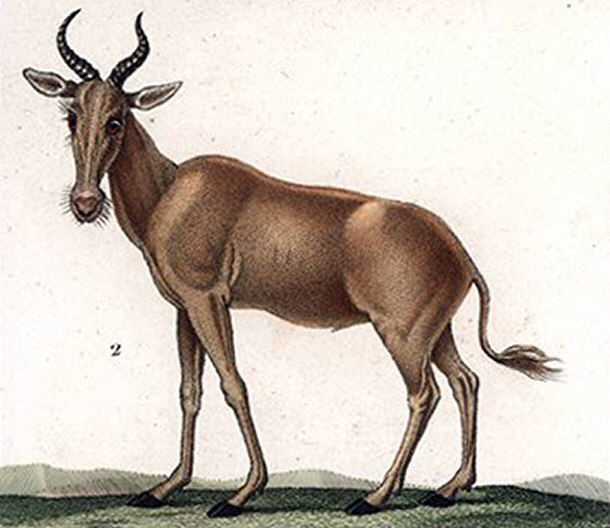
This species of antelope lived until 1923. The decline began in the 19th
century, due to the colonial military of the French, after they conquered
Algeria, who massacred entire herds for some unknown reason. Its numbers, along
with where it could be found, continued to decline. By the early 1900s, you
could only find the Bubal Hartebeest in Algeria and the Moroccan High Atlas
Mountains. Further hunting reduced its numbers until it was no longer around.
There are closely related species still living in southern Africa, like the Red
Hartebeest and Lichtenstein's Hartebeest.
3) Moa
Moa lived in New Zealand up until the 1500s. There were actually numerous
species of moa, anywhere between nine and twelve, and they belonged to the order
Dinoronithiformes within the ratite group. They were flightless birds akin to
the emu and ostrich, although they were the only wingless birds without even
vestigial wings within the ratite group. Although it was previously considered
that their closest living relations were the kiwi, Australian emu and cassowary,
it is now believed that the tinamous are actually their closest relation.
However, the tinamous can fly, unlike the moa. Although the moa typically are
depicted standing upright, most likely they held their heads forward. They were
able to graze vegetation found both on the ground and in the lower levels of
trees.
Giant Moa
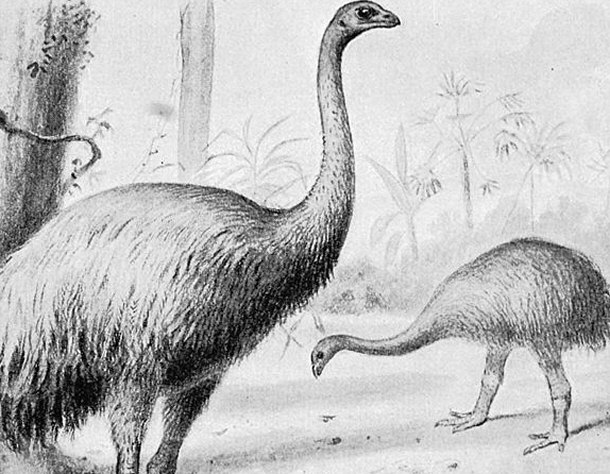
For thousands of years, the moa dominated the landscape of New Zealand,
including the forest, shrubland and subalpine areas. They only had to worry
about the Haast Eagle as a predator. However, its huge size, over 12 feet high
and 500 pounds, did not stop them being hunted out by the Maori. The Maori
arrived in New Zealand sometime prior to the 14th Century. Within a century,
almost all the moa were gone due to hunting, habit reduction, and forest
clearance, showing it is not just modern man that can wipe out a species
quickly. There are rumors they continued to exist until the 19th Century, but
most scientists disregard these hearsay tales.
2) Titanoboa
If you are deathly afraid of snakes, then you will be happy that the titanoboa have been extinct for over 58 million years. Most likely a precursor
to the modern day boa constructor, this prehistoric creature could grow to 50
feet long and weighed over 2500 pounds. That's a snake as long as 2 busses that
weighed more than a minivan. This genus of snake lived during the Paleocene
epoch, around 60 to 58 million years ago. The only species within this genus,
the titanoboa carrejonensis, is the largest, heaviest, and longest snake ever
discovered. The fossils of this snake have been found in the Carrejon Formation
in Correjon, La Guajira in Columbia, meaning it would have lived in the tropics.
Titanoboa Consuming Crocodile
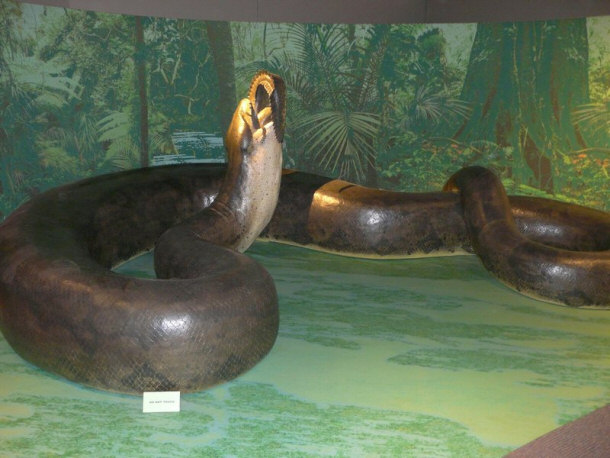
One scientist in 2011, Charlie Brinson, created a 33-foot long
electro-mechanical, robotic version of this giant snake. In 2012, a full-scale
model replica was displayed at Grand Central Station in New York to help promote
a TV show about the snake on the Smithsonian Channel. We didn't go look at it
because we wanted to sleep again eventually.
1) Baiji River Dolphin
The Baiji River Dolphin is the first aquatic mammal that died out in modern
times due to human influence, becoming officially extinct in 2006. This species
of dolphin was freshwater found only in the Yangtze River. They first appeared
around 25 million years ago as they migrated from the Pacific up the Yangtze
River. It is one of only four species of dolphins that have become exclusive
freshwater inhabitants. An ancient Chinese dictionary Erya from around the 3rd
century B.C.E. described the baiji in a story about a princess who drowned
herself because she did not want to marry a man forced upon her by her parents.
From this ancient tale, the dolphin became a symbol of peace and prosperity,
nicknamed the "Goddess of the Yangtze."
Yangtze River Dolphin

As China became more industrialized, including using the river for fishing,
hydroelectricity and transportation, the species began to die out. By 1950s,
there was an estimated 6,000 dolphins living in the river, but they soon began
to decline. There was a possible sighting in 2007, but nothing confirmed.
Because Baiji river dolphin died out only a few years ago, scientists were able
to extract its DNA. They are currently attempting to clone it in order to
recreate the species. However, even if they are successful, one major problem
remains: no one knows where to put it. The Yangtze River is now heavily polluted
with 12 percent of the entire world's population living among its banks.
Conclusion
These fifteen species of animals joined millions of others that have once
lived upon the Earth but can no longer be found. Some have even morphed into
local legends like the Loch Ness monster, while others may never be discovered.
However, as the more recent examples of extinct animals reveal, humans have a
strong, negative impact on Mother Nature. Whether it was the Maori in the 14th
Century killing the moa or modern man killing the baiji, humans have contributed
to numerous species' decline and death. Too many times, humans have tried too
little, too late to reverse the fate upon these animals. As more and more
animals make the endangered lists, the question remains how to help reverse the
decline of the species. Hopefully they'll stick to friendly animals and not
recreate Jurassic Park.
Nature
Top Lists:
15 Fascinating Facts about the Amazon Rainforest
15 Remarkable Facts About Bacteria
15 Remarkable Facts About Jellyfish
15 Little Known Facts About Elephants
15 Fascinating Facts about Earthquakes
15 Odd And Interesting Facts about Monkeys
Top 15 Myths about Snakes
Top 15 Myths about Horses
Top 15 Creepy Deep Sea Creatures
15 Unexpected Animals That Can Kill You Quickly
Top 15 Spider Myths
15 Beautiful Animals that are Now Extinct
Top 15 Most Amazing Snakes Around the World
15 Fascinating Facts about Snow
Top 15 of the World's Rarest Flowers
10 Most Emotional Animals
15 of the Most Venomous Creatures to Roam the Earth
15 Unusual Animal Defense Mechanisms
15 Unusual and Less Known Uses of Rocks
15 Unique Forest Creatures Less Known To Man
15 Interesting Facts About Time
15 Unknown Parasites You Never Knew Existed
15 Weird Trees Around The World
15 Wild Animals Deadly to Humans
15 Exotic Insects That Are Harmful & Deadly
15 Ridiculous Uses for Gold
Informational:
Preparing for a Disaster
Proof That We Are What We Are!
What is the Meaning of Life?
The Trend and Challenges Facing the Urban World
Creation Narratives and the Evolution Creationist Debate |